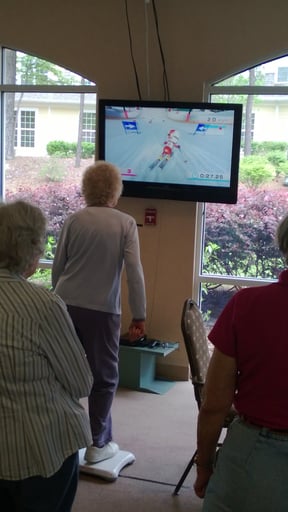 Twenty years ago, if someone had suggested purchasing video games for a retirement community, they would have been laughed at. “Those are for kids,” would have been the response. “No one over 60 is ever going to be interested in that.” I’m here to tell you times have changed! Now, everywhere you look people of all ages are getting in on the action and testing their skills in the virtual world.
Twenty years ago, if someone had suggested purchasing video games for a retirement community, they would have been laughed at. “Those are for kids,” would have been the response. “No one over 60 is ever going to be interested in that.” I’m here to tell you times have changed! Now, everywhere you look people of all ages are getting in on the action and testing their skills in the virtual world.
Here are just three of the systems popping up in communities all over the country.
Nintendo Wii
This is probably the most popular one for communities because it’s been around for quite a while now and it’s fairly easy to use. The Nintendo Wii is a low-cost, commercially available interactive gaming system that gives immediate visual feedback in balance training. For most Wii games, players hold a remote and use it as the golf putter, baseball bat, bowling arm, etc. to play.
An optional add-on is the balance board for the Wii Fit game, which enables a user to test his or her center of balance with a visual display onscreen that shows what percentage of their body weight they carry over each foot. Those with an uneven center of balance will unnaturally compensate for their imbalance, which can cause their posture to become misaligned, increasing the level of stress on their bodies. The game allows users to learn about their balance and provides them with tips for improving an uneven center of balance with several different training modes, including yoga, strength training, balance games, and aerobics.
Xbox Kinect
The Kinect has been around for a few years as well, but it’s certainly newer technology than the Wii. There is no remote to hold or board to stand on. There is simply a camera that points at the general space where you’re playing and then your body is the “remote.” The Kinect generally requires a bigger space than the Wii and it’s more expensive, but the games are also more advanced. If you are working with a more active community, this may be the way to go. There is a lot more foot movement required for most of the Kinect games, so be sure to educate residents on safety before really getting into the action.
PlayStation Move
The idea of the PlayStation Move is very similar to the Wii. Each person has a remote and their motion is captured by a camera that’s plugged into the gaming system. I don’t have personal experience with this system, but from the reviews it looks like the movements and reaction time of the sensors/camera are much better on the Move than on the other two systems. Of course, that’s coming with a higher price tag, so you’ll have to weigh the pros and cons yourself. The Move offers a wide array of game options, from the mostly sedentary to the action-packed.
All three systems are great options for your senior living community. They do range in price, but you can often find a refurbished/used version of the system online or at your local GameStop store. Each system has a range of exercise options, from the traditional fitness games, to dance games, to more of the recreational pastimes. No matter which console you choose, they all encourage more physical activity in the community, and isn’t that the goal at the end of the day?
Also, there’s an added perk of having these systems available at your community. When grandkids come to visit, these consoles provide a great activity that spans generations. Think of how impressed that 10-year-old will be when grandpa shows them how to score big at the Home Run Derby on Wii!
How have you used gaming systems to improve your senior fitness program’s physical activity?

